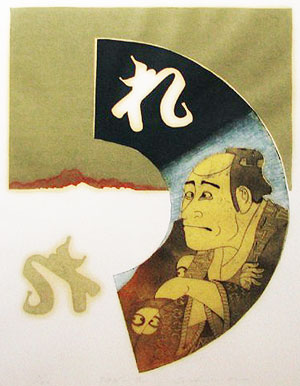

OUCHI Makoto (大内マコト)
|
 Ouchi Makoto (大内マコト) was born in Kawasaki, Kanagawa Prefecture, and entered the Independent Artist's Association in 1957. His first solo show took place in 1958 at the Japan Club in New York. He later won the Yamamoto Kanae Prize from the Japan Print Association in 1968, and was later elected twice as secretary-general of that association.
Ouchi Makoto (大内マコト) was born in Kawasaki, Kanagawa Prefecture, and entered the Independent Artist's Association in 1957. His first solo show took place in 1958 at the Japan Club in New York. He later won the Yamamoto Kanae Prize from the Japan Print Association in 1968, and was later elected twice as secretary-general of that association.
Ouchi combined etching with the use of paper blocks for printing the flat color areas. This contrasted with the embossed sections where the printing press "hollowed out" the etched areas.
The American expatriate artist Clifton Karhu once recalled, "Ouchi is very traditional and very modern. In his work there is always an element of the past. Whether it is the fan shape or the use of a Sharaku head or a Hokusai wave, the feeling of Japan is there, and then he transforms it into something contemporary.... Another thing is that among Japanese he is unmistakenably an individual ... Even though he uses images from the past, what comes from his press is different. He follows no one but himself."
Ouchi's prints are in many public and private collections, including Museum of Modern Art, NY, Museum of Fine Arts, Boston, Cincinnati Art Museum, and the Library of Congress.
In the design shown here, Ouchi has borrowed from a celebrated actor print by Tôshûsai Sharaku depicting Arashi Ryûzô as Ishibei Kinkichi, a moneylender, performed at the Miyako-za, Edo in 5/1794. Ouchi's print is numbered 3/80 and titled "Ran - re" but is undated (circa 1970s-80s?). The image size is 530x363mm on paper measuring 621x491mm.
The hiragana character "re" (れ) appears in reserve (unprinted white paper) at the top of the fan and is also printed in reverse (mirror image) at lower left. The russet color for the robe was applied with a textured gradation, and "foul biting," normally an undesirable artifact of the etching process, has been used to intentionally add pattern to the skin of the actor. There is an undercurrent of playfulness in Ouchi's take-offs on ukiyo-e themes, quite apt for a modern sensibility. Yet his attitude would have likely been appreciated by the denizens of the Edo-period "Floating World," no slouches themselves when it came to the culture of play (asobi: 遊). © 2001-2019 by John Fiorillo
BIBLIOGRAPHY
- Blakemore, Frances: Who's Who in Modern Japanese Prints. New York and Tokyo: Weatherhill, 1975, pp. 153-155.
- Tolman, Mary S. and Norman H. (eds.): Aramusha --- Ouchi Makoto: The Artist Warrior. Tokyo: Sobunhsa, 1982
- Tolman, Mary S. and Norman H.: People Who Make Japanese Prints—A Personal Glimpse. Sobunsha, Tokyo, May 1982, pp. 21-22 and 114-127.
Viewing Japanese Prints |